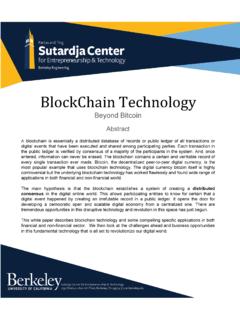Transcription of Deloitte UK Blockchain Key Challenges
1 To start a new section, hold down the apple+shift keys and click to release this object and type the section title in the box the Blockchain ecosystem evolves and different use-cases emerge, organisations in all industry sectors will face a complex and potentially controversial array of issues, as well as new dependencies. Awareness and understandingThe principal challenge associated with Blockchain is a lack of awareness of the technology, especially in sectors other than banking, and a widespread lack of understanding of how it works. This is hampering investment and the exploration of ideas.
2 As George Howard, contributor to Forbes Media and Entertainment, says about the music business, A r t is t s visual, musical, or otherwise really must educate themselves about these emerging technologies, or suffer the fate of being exploited by those who do .32 This is a message that applies to organisations, questions every leader should ask: Who is a thought leader in my industry in Blockchain technology? To whom do I turn to in my organisation to explain blockchains? How do we increase our level of understanding at all levels? Is a Blockchain right for my organisation?
3 And, if so, how are we thinking about applying it and what would this mean organisationally and culturally? With whom do I interact within my organisation to collaborate and deliver? What are my competitors and peers saying about Blockchain ? Organisation The Blockchain creates most value for organisations when they work together on areas of shared pain or shared opportunity especially problems particular to each industry sector. The problem with many current approaches, though, is that they remain stove-piped: organisations are developing their own blockchains and applications to run on top of them.
4 In any one industry sector, many different chains are therefore being developed by many different organisations to many different standards. This defeats the purpose of distributed ledgers, fails to harness network effects and can be less efficient than current approaches. Key questions every leader should ask: What problems or opportunities does my organisation share with others in the sector? Will a Blockchain approach still leave a marketplace in which we can compete? What are the bottlenecks that might prevent us from working together? How can we take a lead in bringing the community together?
5 How many organisations would be needed to create a critical mass? What are the common standards we require?Key Challenges There have been a few different start-ups trying to create basically their own blockchains with specific use-cases. In our view we feel that kind of defeats the purpose of having a network itself because it just recreates silos. 31 Tim Swanson, head of research at R3 CEV10To start a new section, hold down the apple+shift keys and click to release this object and type the section title in the box Blockchain represents a total shift away from the traditional ways of doing things even for industries that have already seen significant transformation from digital technologies.
6 It places trust and authority in a decentralised network rather than in a powerful central institution. And for most, this loss of control can be deeply unsettling. It has been estimated that a Blockchain is about 80 per cent business process change and 20 per cent technology This means that a more imaginative approach is needed to understand opportunities and also how things will questions every leader should ask: Where can we pilot new Blockchain approaches on the edges of our business? Who will be most affected by Blockchain implementations and are they supportive? Which areas of our business are likely to be most disrupted?
7 Have we thought about impacts on our strategy, organisational structure, business processes, governance, talent and legacy systems?Cost and efficiencyThe speed and effectiveness with which Blockchain networks can execute peer-to-peer transactions comes at a high aggregate cost, which is greater for some types of Blockchain than others. This inefficiency arises because each node performs the same tasks as every other node on its own copy of the data in an attempt to be the first to find a solution. For the Bitcoin network, for example, which uses a proof-of-work approach in lieu of trusting participants in the network, the total running costs associated with validating and sharing transactions on the public ledger are estimated to be as much as $600 million a year and This total does not include the capital costs associated with acquiring specialist mining hardware.
8 Blockchains are something of a productivity paradox, therefore. At the scale of the entire network the process is significantly productivity enhancing, but requires a certain critical mass of nodes. Yet, even so, individual nodes can work extremely hard and may not contribute very much to the network overall. Therefore, decisions about implementing Blockchain applications need to be carefully thought through. The returns to individual processing nodes either individuals in a public Blockchain or organisations in a sector-wide Blockchain may diminish as the network grows in size. This means that Blockchain applications must harness network effects to deliver value to consumers or to sectors at questions every leader should ask: What is the business case for implementing a Blockchain ?
9 How do we make it pay? What are the bottlenecks in the processes we are replacing with the Blockchain ? What are the main drivers of cost in our implementation of the Blockchain ? How can the cost and processing load be shared among participating organisations? Blockchain Enigma. Paradox. Opportunity 11To start a new section, hold down the apple+shift keys and click to release this object and type the section title in the box and governanceRegulations have always struggled to keep up with advances in technology. Indeed, some technologies like the Bitcoin Blockchain bypass regulation completely to tackle inefficiencies in conventional intermediated payment networks.
10 One of the other Challenges of the Blockchain approach, which was also one of its original motivations, is that it reduces oversight. Centralised systems, particularly in financial services, also act as shock absorbers in times of crisis despite their Challenges and Decentralised networks can be much less resilient to shocks, which can impact participants directly, unless careful thought is given to their design. There is thus a strong argument for Blockchain applications to work within existing regulatory structures not outside of them, but this means that regulators in all industries have to understand the technology and its impact on the businesses and consumers in their sector.


















